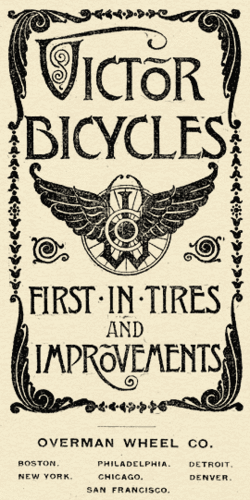Writing Her First Book
How Anna Katherine Green’s “The Leavenworth Case” Came to See the Light
Buffalo, May 26 — Seated in the pleasant ground floor room of her cosy home on Norwood avenue, in which she does her writing, Mrs. Charles Rohlfs (Anna Katharine Green) told a friend to-day how she began the production of the remarkable series of ‘criminal romances‘ which have made her one of the most widely read fiction writers of the present day.
Her passion for writing first manifested itself when she was literally a mere child, but her earliest literary ambitions were all in the direction of verse. Indeed, a complete edition of her books would include a volume of poems, first published some years ago, and fairly successful, though not to be compared with her stories. She began to write in rhyme and measure when only 7 or 8 years old, and her brother, three or four years older, who owned a toy printing press and a font of type, used to set up and print her girlish productions, the two children playing ‘author and publisher’ to their own great satisfaction.
After a while her pieces of verse were longer and more ambitious, and by and by the narrative element crept into them. Then on the advice of her stepmother, the young girl attempted a story in prose, over which she labored long and earnestly, only to destroy it at last as altogether unworthy. Yet it must have had some merit for as she now remembers it the plot contained the germs of ‘The Leavenworth Case,’ which was the solid foundation of her present fame. Though neither she nor anyone else was aware of it at that time, that period of her life was an important link in her mental development. She seemed fairly possessed with the impulse to construct stories, and much of the time which she would otherwise have devoted to play was given up to lonely walks during which she told long and ingenious tales to herself.
At 18 she was sent to the Ripley Female college in Vermont and her school duties occupied her time and energy until after she was graduated. Then she returned to her home in Brooklyn where the suggestion that she turn to fiction was renewed, and she concluded to make the attempt. From that time till a date quote two years later she lived in a little world of her own. She had the plot all mapped out before she began, but it had to be changed and modified as the work progressed, and much of the writing had to be done over and over again. On several occasions she felt sorely tempted to burn the manuscript and forget it. It was not until the story was two thirds written that she dared say anything about it to anyone.
 Then she showed the copy to her father, who read it, saw that she had struck a vein, and encouraged her to finish the tale, albeit he suggested many modifications. These the daughter accepted without question, for her father was a lawyer, and his suggestions were all along the line of practicality, logical development and conformity to the legal technicalities in the parts which had to do with the courts.
Then she showed the copy to her father, who read it, saw that she had struck a vein, and encouraged her to finish the tale, albeit he suggested many modifications. These the daughter accepted without question, for her father was a lawyer, and his suggestions were all along the line of practicality, logical development and conformity to the legal technicalities in the parts which had to do with the courts.
‘I felt grateful to my father for his kindness in helping me,’ says Mrs. Rohlfs when talking of the circumstances now, ‘but I must confess that the way he tore some of my most cherished construction all to pieces was almost disheartening. However, I reconstructed and pieced together the parts which he had condemned, and set about completing my work.
‘I was then eager to take the copy to a publisher, but my father suggested that it ought to be revised again and by a judge. So to a judge of our acquaintance the copy was taken, and he waded through it most patiently. I say this advisedly, for, as it then stood, the manuscript of The Leavenworth Case was the strangest looking mass of paper you ever saw. You see, I had written part of it at home in Brooklyn, part of it at the seashore, part of it in the mountains and other parts wherever I had chanced to be as a guest, on journeys and so on. I had procured my paper and ink from the nearest dealer in every case without a thought to uniformity. Chromatically the copy was more like Joseph's coat of many colors than anything else I can compare it to, for some of the paper was white, some blue, some pink and some buff. But the judge was very encouraging in his report on the work. It had held his interest from the first to last, he said, and the only criticism that he could offer was on my use in one place of the word ‘equity.’ So far as the word’s ordinary meaning was concerned I had used it properly, but it had a significance in legal parlance which I had failed to grasp.
‘Well I fixed up the word equity and took the much scarred manuscript to the head of a well known publishing house. He didn't mind the appearance of the copy—though I’ll confess I’d hesitate to offer such manuscript to any one nowadays—and had it read. He warned me, though, that 150,000 words was altogether too long.
‘The reports of the readers were favorable in the main, but the publisher would not regard them as conclusive. “Now,” he said, “you cut out 60,000 words and then get Rossiter Johnson to read it. If he reports favorably we'll bring out your book.” It had been hard enough work to write the story in the first place, but it was harder still to cut out one-third of what had cost me so much time and effort, but I shut my eyes so to speak and after several days of hard work the excisions were performed.
‘Mr. Johnson, as it chanced, was a friend of our family, and though a very busy man, he was willing to pass on the story. He came to our house in Brooklyn for that purpose, and in view of the condition of the copy I volunteered to read it to him. So he settled himself comfortably in his chair and I began. He said that if it were very bad I needn’t read it at all, and, though he said it more as a joke than anything else, this filled me with a terror that can be more easily understood than described. After I had read two or three chapters I noticed with alarm that his eyes were closed, and, thinking that possibly he might have fallen asleep through sheer lack of interest, I stopped. There was a pause of perhaps half a minute—then, without opening his eyes he said the one word, “More!” So I went on till midnight or later, when the reading was suspended till next day. After it was all read Mr. Johnson was good enough to give the story his approval. In due time the book came out, and that is how I made my start as a story writer.’
All the manuscript Mrs. Rohlfs writes now is read aloud, as was that of “The Leavenworth Case” but the author is rarely the reader. When she is producing a story she devotes a major part of the day to the work, writing rapidly for several hours, after which she devotes some time to correction. In the evening, when the lamps have been lighted, she and her husband and the governess of their children gather about the table in her writing room. Mr. Rohlfs reads and the others listen, until one of the three has a criticism to make. In the nature of things the criticisms are oftenest made by the author herself, and she is constantly making notes of the way the story strikes her as the reading progresses.
 When Mrs. Rohlfs is writing, however, she devotes herself very closely to the work, beginning at 9 o’clock in the morning and sometimes writing or recasting well into the night, after the regular evening’s reading has been accomplished. It takes days to adjust herself to a new piece of work, but once she has begun nothing can drive it out of her mind. This does not mean that everything also must give way to the story; indeed, she often acts as hostess or as guest and goes out to entertainments and social functions while she is writing a piece of fiction, the same as at other times. But whatever she does she never lets go of the thread of the story, and thus in a way she almost leads a double existence from the beginning of the work to its finish.
When Mrs. Rohlfs is writing, however, she devotes herself very closely to the work, beginning at 9 o’clock in the morning and sometimes writing or recasting well into the night, after the regular evening’s reading has been accomplished. It takes days to adjust herself to a new piece of work, but once she has begun nothing can drive it out of her mind. This does not mean that everything also must give way to the story; indeed, she often acts as hostess or as guest and goes out to entertainments and social functions while she is writing a piece of fiction, the same as at other times. But whatever she does she never lets go of the thread of the story, and thus in a way she almost leads a double existence from the beginning of the work to its finish.
There are three children in the Rohlfs family — Rosamond, 15, Sterling, 13, and Roland, 8. Out of study hours they spend much of their time in the writing room of the author and much in the studio where their father constructs the chairs and tables and other artistic articles of household use and adornment that have attracted the attention of those who appreciate such things.
Mrs. Rohlfs is a deeply religious woman, who believes faith should be chiefly manifested in works, and there are many in Buffalo whose worldly success has not been marked that can testify to her practical charity and helpfulness.
[If anyone has access to Kansas City Star archives, I’d welcome better scans of the images from this article — mfh]





